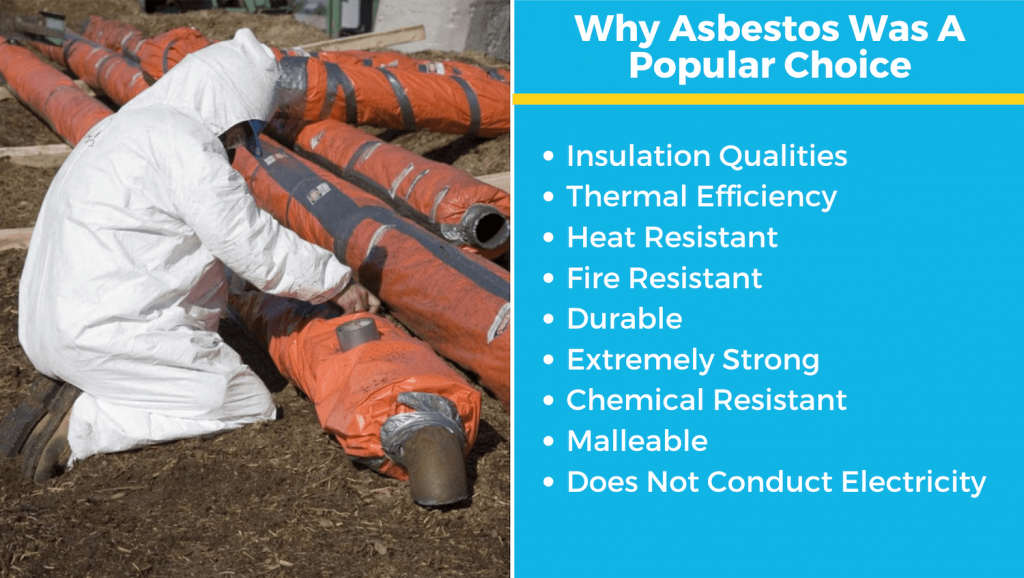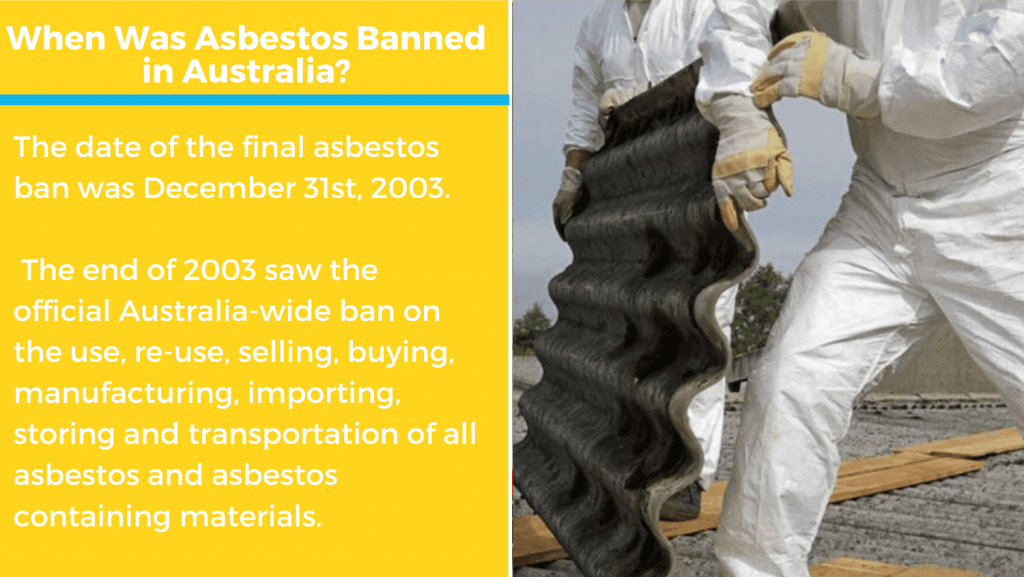
Find out when asbestos was banned in Australia and how the government regulates the importation, sale, and use of asbestos-materials today.
Australia has a long, drawn-out history with the importation, use, and mining of asbestos materials. Once seen as the miracle construction material because of its ‘idyllic’ properties, Australia was responsible for one of the highest consumption rates of asbestos per capita.
The eventual ban on asbestos and asbestos products was consequential of the detrimental health effects it left on those who previously worked with and in the presence of the toxic material. Today, despite the strict asbestos bans, Australia continues to be burdened with a substantial asbestos legacy.
Prior to the increased awareness into the dangers of asbestos, the material was widely used in the construction and manufacturing industries. Introduced to Australia in the early 1900s, asbestos was affordable, accessible and the naturally occurring mineral holds a number of properties that were beneficial industrially.

Asbestos fibres are thin, wiry, and malleable in nature. The structure of the mineral means that asbestos held good a number of beneficial construction properties. These include insulation qualities, thermal efficiency, fire resistance, strength and durability, chemical resistance, and a lack of electrical conductivity. As time went on and more workers continued to work, mine, and construct with asbestos materials, it became evident that the health risks involved drastically overshadowed the benefits of the material.
When Was Asbestos Banned?
By the late 1970s, the Australian Broadcasting Corporation produced a series of programs focusing on asbestos awareness and the effects of asbestos among workers in the industry. The publicity around the campaign leads to increased awareness and a political investigation into the impacts of asbestos exposure for those working in and around asbestos materials.
It was during the 1980s that asbestos was phased out in favour of asbestos-free products in domestic and residential building materials. Despite the clear correlation between the use of asbestos and asbestos-related illnesses. Asbestos was banned in Australia on the 31st of December 2003. The ban makes it illegal to import, store, supply, sell, install, use or re-use asbestos materials.
An Australia-wide ban on the manufacture and use of all types of asbestos and asbestos-containing materials was the result of tightening government regulations and improved workplace health and safety legislation. Trade unions played a critical role in forcing State and Commonwealth agencies to enforce legislation that would protect workers.

The Asbestos ban in Australia does not apply to asbestos material already in place. Due to the widespread use of asbestos materials in the second half of the 20th century, Australia has a large number of legacy asbestos-containing materials still remaining in the built environment.
Where Asbestos Was Asbestos Used?
Asbestos materials were heavily used nation-wide. Asbestos cement materials were a popular residential building material from the mid-1940s until the late 1980s. It was during the 1980s in which asbestos was phased out in favour of asbestos-free materials and products, before being entirely banned Australia-wide. The Department of Health has stated that approximately one-third of Australian homes contain asbestos in some form or another. As a general rule of thumb, if your house was built prior to 1990, it is likely to have asbestos-containing materials.
Asbestos materials can be divided into two groups; non-friable and friable. Non-friable products were more common in households, as they are essentially asbestos materials mixed in with other materials i.e. cement, to provide the overall product with the asbestos beneficial properties. The most common asbestos-containing products were bonded, mixed with cement and included:
- Roofing Sheets
- Shingles & Siding
- Interior & Exterior Wall Cladding
- Fencing
- Thermal Boards Around Fireplaces
- Water or Flue Pipes
- Eaves
There are also a number of friable (meaning the raw asbestos fibres are easily exposed and released into the air) asbestos products that can be found on residential properties:
- Loose-fill Insulation (Mr Fluffy)
- Asbestos-Rope Door Gaskets in Wood Stoves
- Spray-on Insulation or Sound Proofing
- Low-density Asbestos Fibre Board
- Textured Paints & Decorative Ceiling Coatings
- Carpet Underlay
- Insulation on Hot Water Pipes, Heaters & Stoves
- Backing Material on Floor Tiles & Vinyl Flooring
- Heat Resistant Fabric
- Brick & Plaster Sealants
- Damaged, Worn & Aged Bonded Asbestos Materials
Friable asbestos materials are the most harmful asbestos materials. The raw fibres are airborne, small, incredibly dangerous and when inhaled, can cause serious health concerns. The more friable an asbestos material becomes, the more potential it has to cause harm to health.

Mining of Asbestos in Australia
Several asbestos mines were established in Australian in the 1930s, following the discovery of crocidolite and chrysotile. Australian asbestos was commonly exported to a number of countries including Japan, the United Kingdom and the United States, with 1.5 million tonnes of asbestos exported between 1930 and 1983. Many workers were exposed to asbestos through the process of mining and exporting to other countries.
One of the largest and most devastating asbestos mining sites in Australia was the town of Wittenoom in Western Australia. Wittenoom now stands as the most contaminated site in the southern hemisphere and has been wiped off all Australian maps.
The town of Wittenoom was originally built to support the mining of crocidolite. However, it was closed down in the 1960s due to growing concerns about the health risks associated with asbestos mining. By the time the mine was closed, it was too late for many residents that were exposed to the toxic fibres. Approximately 2,000 former Wittenoom residents are believed to have died from asbestos-related illnesses, with many more developing associated diseases such as asbestosis, lung cancer, and mesothelioma.
The Australian State to mine the largest tonnage of chrysotile was New South Whales. Mining of asbestos in Baryulgil and Woodsreef continued until the late 1970s and early 1980s when the overhead costs of dust control and health concerns became too high and the mines were no longer profitable nor safe.
Asbestos Related Diseases
There are three main asbestos-related diseases directly linked to asbestos exposure. Asbestos-related diseases often take years to develop, with the average latency period between exposure and diagnosis being upwards of 25 years. The nature of asbestos fibres means that they are difficult to break down and become permanently trapped in the body when inhaled. The risk of developing an asbestos-related disease is increased with higher exposure time and amount of asbestos.
1.Asbestosis
Asbestosis occurs when asbestos fibres become trapped in the lung membranes, aggravate the lung tissue, and as a result, cause scarring. Asbestosis is a long-term inflammation condition and can lead to further health complications including lung cancer, mesothelioma, and pulmonary heart disease. Symptoms of asbestosis include shortness of breath, wheezing, coughing, and chest pain. Asbestosis is one of the milder asbestos-related diseases.
2. Lung Cancer
When asbestos fibres are inhaled, the fibres become lodged in the tissue of the lung. Over many years, the fibres can cause enough genetic and cellular damage to cause lung cells to turn cancerous. Lung cancer is the largest contributor to asbestos-related deaths in Australia. Symptoms include shortness of breath, chest pain and coughing up blood. Smokers have a higher chance of developing asbestos-related lung cancer.
3. Mesothelioma
Mesothelioma is a rare but aggressive form of cancer that develops in the membrane lining of vital organs. Asbestos exposure is directly linked to the development of mesothelioma cancer cells in the lings of the lungs and chest wall. Asbestos fibres can easily be ingested or inhaled, then become imbedded in organ linings. The fibres cause irritation and mutation of the mesothelioma and result in cancerous cells. The average life expectancy of mesothelioma patients is 12-21 months after diagnosis. Symptoms include shortness of breath, fatigue, and chest pain.
Australia has one of the highest rates of mesothelioma in the world. These predominantly have been cases associated with occupational exposure from asbestos miners, to manufacturers, to the second wave of tradespeople working with asbestos products.
While occupational asbestos-related disease cases are expected to decline due to the ban on asbestos materials, the number of non-occupational cases is beginning to rise, constituting a new wave of asbestos sufferers. This new wave of asbestos exposure cases is largely associated with Do-It-Yourself (DIY) renovators undertaking repairs and renovations on houses without realising they may be exposing themselves to asbestos in the process.

Asbestos Regulations Today
The need to regulate procedures for the safe management, removal, disposal, and remediation of asbestos-contaminated sites has become a priority in recent decades in Australia. As the incidence and awareness of asbestos-related diseases has increased, and as many asbestos-containing materials begin to age and deteriorate, it’s important for homeowners and property owners to be aware of the best practices around asbestos removal and management.
Today, the regulations on asbestos use and importation are still strictly enforced. The problem we now face is the prevalence of asbestos-containing materials on residential, commercial, and industrial sites from previous use. Workers engaging with any old asbestos materials must be appropriately trained, licensed, and have an asbestos management plan in place.
Unless you’re removing less than 10m2 of non-friable asbestos, you must be licensed to remove and handle asbestos. Even if you are removing less than 10m2 of non-friable asbestos, it is still recommended you engage a licensed asbestos removalist instead as the risk of asbestos exposure is very high.
Under the model WHS Regulations, two licensed have been established: Class A and Class B. Those who hold Class A licensed are permitted to remove all types of asbestos, including friable and non-friable. Class B licensed holders can only remove non-friable, bonded asbestos materials. Here at GBAR Group, we are fully licensed with Class A accreditations. Our team have been working with asbestos and hazardous materials for over 30 years and have the knowledge and experience to safely remove, dispose of, and remediate all asbestos-contaminated sites.
GBAR Group is leading industry experts in the safe removal of asbestos and hazardous materials. Our team are rigorously trained in the safe practice of asbestos abatement to ensure the safety of our clients and their environment. Licensed in NSW, QLD, ACT, VIC, SA, NT, and WA, we command an enviable reputation for integrity, professionalism, and for providing cost-effective contaminated land management solutions. Above all, GBAR is unwavering in our commitment to safety.






